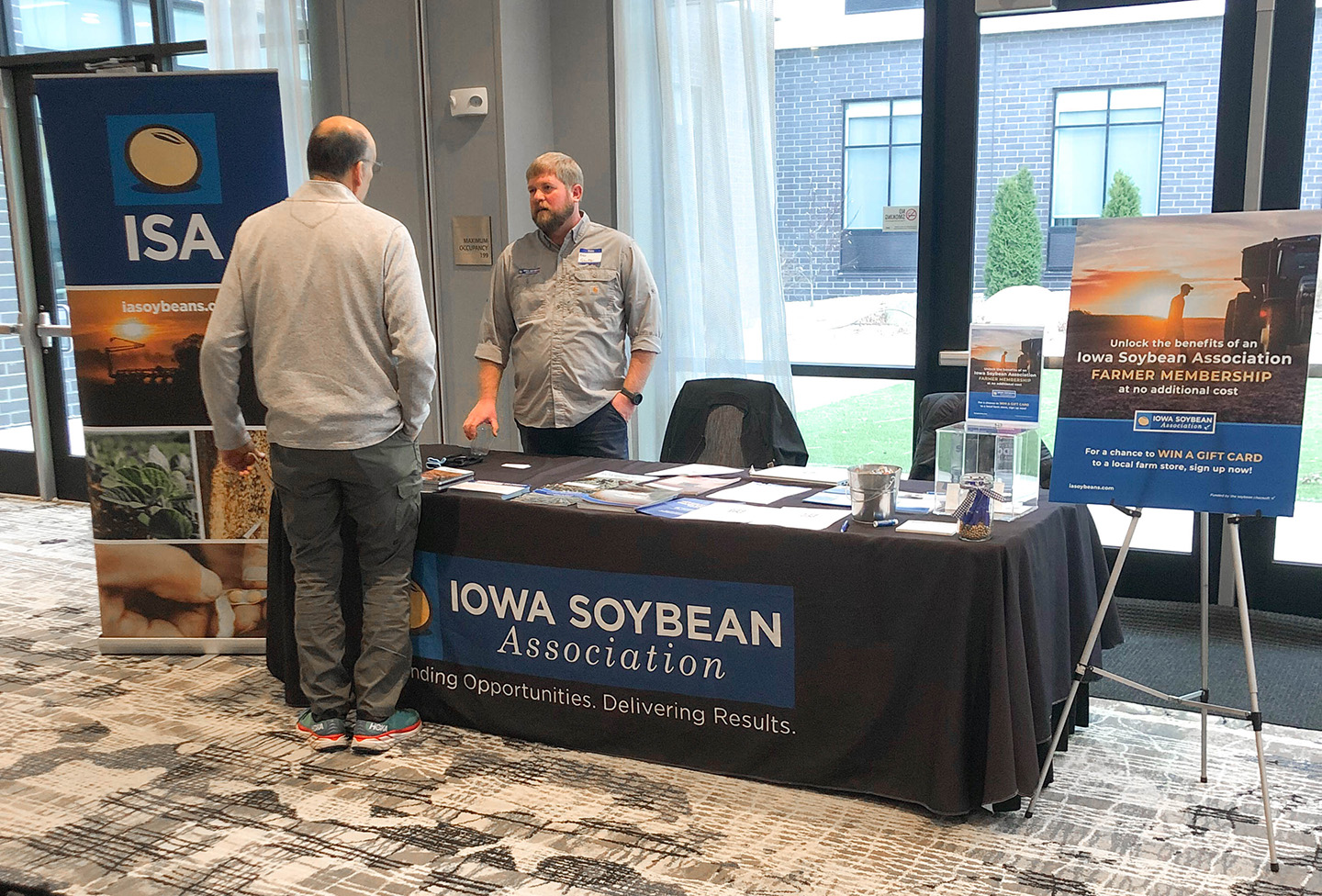
Farmer speaking with ISA agronomist Alex Schaffer was on hand at the Soil Regen LLC Big Soil Health Event (Photo: Julia Edlefson/Iowa Soybean Association).
Learning from the soil health experts
January 4, 2024 | Kriss Nelson
Soil Regen LLC provided a farmer-first education, training and networking experience during their annual Big Soil Health Event held Dec. 11-13.
The Iowa Soybean Association (ISA) was among the event’s sponsors, hosting more than 400 farmers and ag-industry leaders highlighting soil health practice and adoption.
ISA farmer member Keith Lovrien of Clarksville attended the two-day event. The proximity to home and a stellar lineup of advocates and scientists who have made soil health their career attracted him to the conference.
“It helps to stretch your mind on some of the things I could be doing and have been dragging my feet on – such as diversifying cover crops,” says Lovrien. “I come to these events to learn more about opportunities that are out there and be able to hear from speakers and talk to them in person, ask questions and network with other farmers.”
Steve Thompson from Van Horne says although he has been using cover crops for several years, he is learning there is more he can do.
“I haven’t been able to reduce my inputs that much,” Thompson says. “I am trying to figure out what else we can do, including learning how to raise corn and soybeans with less nitrogen and other fertilizers.”
Soil Carbon Initiative
Participants learned about the Soil Carbon Initiative, the first independent third-party regenerative agriculture commitment and verification program.
Alisa Gravitz, president and CEO of Green America is involved with the development and strategy for the initiative where they pride themselves in being farmer-first focused.
Gravitz says they emphasize making a program work for producers agronomically and economically and help address a full range of needs from guidance, financing, market connections and more.
“We want the program to work for all producers from those just thinking about the regenerative journey to those that have been doing it for a long time,” says Gravitz. “We work with all production systems from conventional to regenerative organic. Everybody is welcome.”
The Soil Carbon Initiative measures results and provides information for planning based on a farm’s data.
“We use science plus data to drive decisions,” says Gravitz. “But, we use it in a context that works for people.”
The program also offers transparency plus third-party verification. This offering, according to Gravitz, helps provide credibility and consumer acceptance and meets regenerative requirements for companies, retailers and new markets.
The beginning of a farmer’s regenerative ag journey
Taylor Herren, program specialist for the Soil Carbon Initiative says the first step in helping a farmer interested in the program is to do a self-assessment.
“We get to know them, talk about their challenges, obstacles and goals,” says Herren. “Not all acres are required to be enrolled, we start with what the farmer is comfortable with.”
After the initial assessment, Liz Haney, co-owner of Soil Regen works with the Soil Carbon Initiative by helping people to start their regenerative ag journey.
“We start with soil testing to get a baseline on how their soils are functioning and we can then help make a plan to transition the farm toward a profitable production system,” says Haney.
Once those baseline results are known, the producer works with Haney to develop a plan.
“We then move into the season where the plan is implemented and we continue to provide support and technical assistance,” says Herren. “We are here for the farm transition support.”
Measuring and tracking the soil health progress continues, and eventually, the producer earns a third-party verification and consumer label.
Transparency from soil to shelf
Once a farmer has done the work, it is time to tell the world, Gravitz says. This comes in the form of traceability.
“If you are a company that wants to make a regenerative claim with certain retailers, you have to have transparency and independent verification,” says Gravitz.
Sarah Martello, CEO and co-founder of Transparency Wise, reviews the data collection with producers – looking at the regenerative progress, climate impact and other sustainability outcomes. She then pulls that agronomic and animal data over to the consumer-facing platform.
“Consumers are confused,” says Martello. “How does a brand define sustainability or regenerative agriculture – what goes into that? We are on a mission to collect the data and connect everything in a circular ecosystem. We are facilitating that collaboration of data so everybody can profit from the end product.”
How can soil health help improve a farmer's ROI?
“We focus on reducing inputs,” says Haney. “Not only is it good for soil health, but also for your wallet.”
Data shows yields from fields that have been put into a regenerative agriculture program become more consistent and stable over time.
“There is more security through using regenerative practices,” Haney says.
In addition to reduced input costs, Haney claims there are benefits to better weather protection. Healthy soil, for example, protects crops from the effects of drought and flooding.
Revenue diversification is an added benefit, she says. This comes with opportunities for revenue from rotational crops and other business ventures such as raising cover crops to sell the seeds.
“There are so many benefits to soil health, but also to your operation,” says Haney. “The more you diversify, the more new markets become available.”
Practicing regenerative agriculture could help prepare producers for new and evolving markets such as carbon, water, eco-system service markets and tax credits, Haney says.
A stronger bottom line could make coming back to the farm attractive for future generations, she says.
“If we can diversify our revenue streams and improve soil health and become more profitable, the next generation will want to come back home to the farm and be part of sustainable growing practices.”
Back